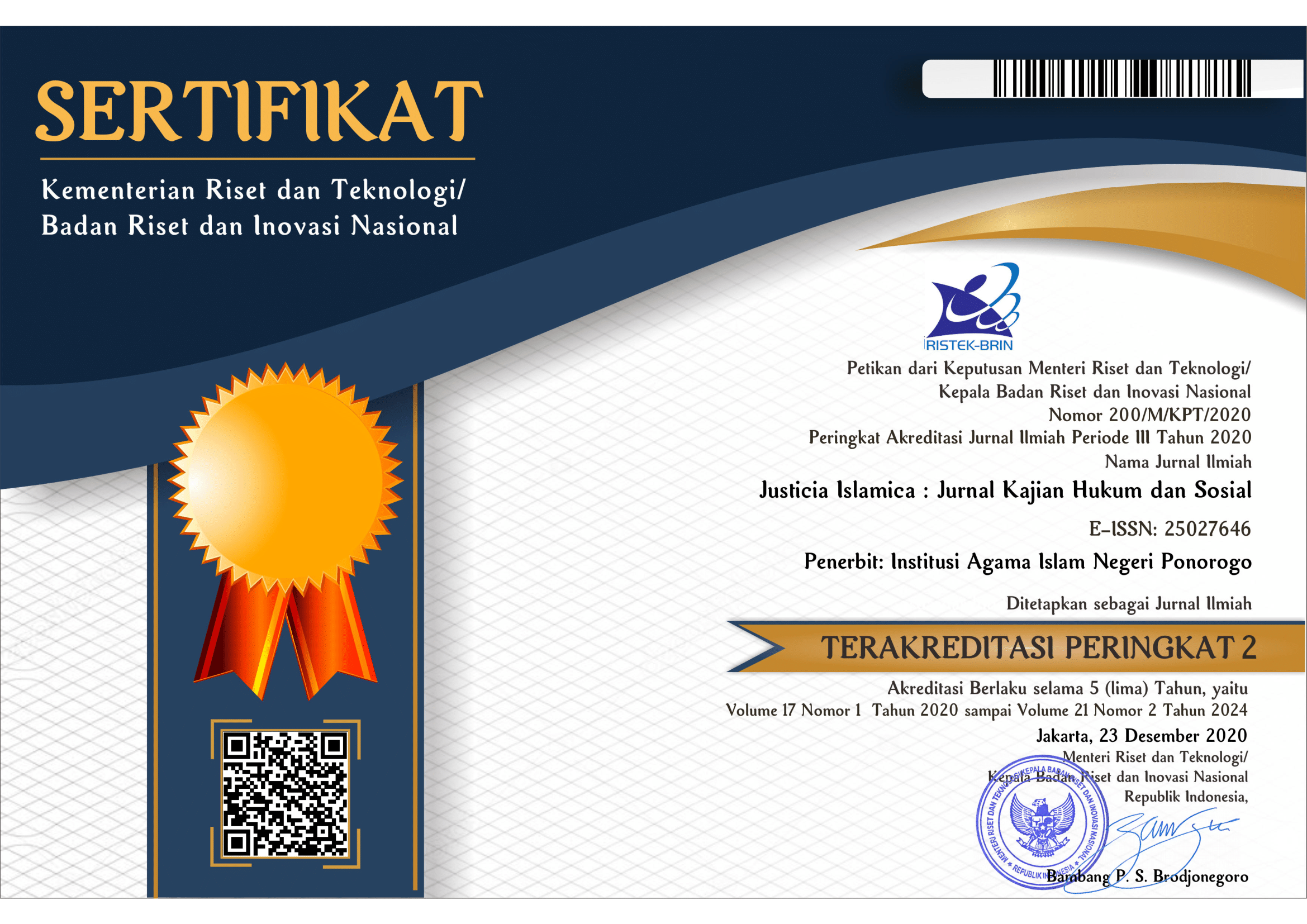The Right to Buyback in Murabahah Akad with the Ba'i al-Wafa' System Based on Maqashid Sharia
DOI:
https://doi.org/10.21154/justicia.v19i2.3873Keywords:
the right to buy back, murabahah akad, ba'i al-wafa' system, maqashid shariaAbstract
The objective of this article is to find out whether the right to buy back under a murÄbaḥah akad with the bay’ al-wafÄ’ system is contrary to maqÄá¹£id al-sharÄ«a or not. MurÄbaḥah akad with the bay’ al-wafÄ’ system is a new type of contract resulting from modification. Applying akad optimally must contain benefits for the community by referring to the maqÄá¹£id al-sharÄ«a. This study uses a normative legal research method with a statute legal approach and a conceptual approach. This study resulted in the findings that the right to buy back in a murÄbaḥah akad with the bay’ al-wafÄ’ system is not contrary to maqÄá¹£id sharia because it provides benefits, profits, pleasure, benefit, and happiness for the parties (seller and buyer). MurÄbaḥah akad with the bay’ al-wafÄ’ system also has fulfilled 5 (five) main elements of realizing benefit, i.e., maintaining religion because it can keep humans from riba; nourish the soul, because sellers who get funds quickly and buyers who make a profit can use them to sustain their lives; maintaining the reason because the seller uses his mind to sell his products to the buyer to get funds to meet his needs, and the buyer uses his mind in seeking lawful sustenance (earning a profit) through the use of this akad; maintaining offspring, because will provide blessings and benefits for children, grandchildren, and their offspring; maintaining the property, because someone who has more assets (buyer) can use his wealth to help other people who need funds.
References
Ahoen, Bahori. “Analisis Implementasi Alternatif Model Jual Beli Pada Produk Jual Beli Tanah Dengan Hak Membeli Kembali Pada Pt Akuisindo Assetama Jakarta Ditinjau Dari Hukum Positif Dan Syariah.” Malia (Terakreditasi) 11, no. 2 (2020): 207”“20. https://doi.org/10.35891/ml.v11i2.1775.
Asa’ari. “BAI’UL WAFA` (Review Penggunaan Dalil Mashlahah Di Kalangan Hanafiyah).” Jurnal Islamika: Jurnal Ilmu-Ilmu Keislaman 13, no. 1 (2013): 77”“90. https://doi.org/https://doi.org/10.32939/islamika.v13i1.20.
Djuwaini, Dimyauddin. Pengantar Fiqh Muamalah. Yogyakarta: Pustaka Pelajar, 2008.
Efendi, Dyah Ochtorina Susanti dan A’an. Penelitian Hukum (Legal Research). Jakarta: Sinar Grafika, 2018.
Fasya, Dewi Wulan. “Jual Beli Dengan Hak Membeli Kembali (Studi Komparasi Antara Kitab Undang-Undang Hukum Perdata Dan Fikih Syafi’i).” Jurisdictie 6, no. 1 (2017): 50”“62. https://doi.org/10.18860/j.v6i1.4089.
Febriadi, Sandy Rizki. “Aplikasi MaqÄá¹£id Syariah Dalam Bidang Perbankan Syariah.” Amwaluna: Jurnal Ekonomi Dan Keuangan Syariah 1, no. 2 (2017): 231”“45. https://doi.org/10.29313/amwaluna.v1i2.2585.
Ipandang, I, and A Askar. “Konsep Riba Dalam Fiqih Dan Al-Qur’an: Studi Komparasi.” Ekspose: Jurnal Penelitian Hukum Dan Pendidikan 19, no. 2 (2020): 1080”“90.
Kawuryan, Retno Wahyurini Dominika dan Endang Sri. “Perjanjian Beli Kembali (Buy Back Guarantee) Antara Pengembang Dan Bank Dalam Penyelesaian Masalah Kredit Macet.” Transparansi Hukum 1, no. 1 (2018): 55”“78. https://doi.org/10.30737/transparansi.v1i1.171.
Kudus, Kudus, and Naghfir Naghfir. “Efektivitas Akad Pembiayaan Bai’ Al- Wafa Pada Baitul Maal Wat Tamwil.” Arena Hukum 10, no. 1 (2017): 1”“19. https://doi.org/10.21776/ub.arenahukum.2017.01001.1.
Muhamad. Lembaga Perekonomian Islam. Yogyakarta: UPP STIM YKPN, 2017.
Nawawi, Ubaidillah. “Tinjauan Istihsan Terhadap Bai’ Al-Wafa’ Dan Implikasi Konsistensi Bermadzhab Di Baitul Maal Wa Tamwil Sidogiri Cabang Bondowoso.” Istidlal: Jurnal Ekonomi Dan Hukum Islam 1, no. 2 (2017): 112”“40. https://doi.org/https://doi.org/10.35316/istidlal.v1i2.103.
Pratiwi, Rahmi dan Noprizal. “Formulasi Hybrid Contract Sebagai Alternatif Pembiayaan Pertanian Di Bank Syariah.” Al Falah: Journal of Islamic Economics 2, no. 2 (2017): 139”“66. https://doi.org/http://dx.doi.org/10.29240/jie.v2i2.
Qosim, Nanang. “Transaksi Jual Beli Dalam Bentuk Khusus (Jual Beli Pesanan, Bay’ Al-Wafa’ Dan Ihtikar.” Asy-Syari’ah Vol. 4, no. No. 2 (2018): 75”“92. https://doi.org/https://doi.org/10.55210/assyariah.v4i2.108.
Rusdi Ali, Muhammad. “Maslahat Sebagai Metode Ijtihad Dan Tujuan Utama Hukum Islam.” Jurnal Syari’ah Dan Hukum Diktum 15, no. 2 (2019): 151”“68. https://doi.org/https://doi.org/10.28988/diktum.v15i2.432.
Setiady, Tri. “Pembiayaan MurÄbaḥah Dalam Perspektif Fiqh Islam, Hukum Positif Dan Hukum Syariah.” FIAT JUSTISIA:Jurnal Ilmu Hukum 8, no. 3 (2015): 517”“30. https://doi.org/10.25041/fiatjustisia.v8no3.311.
Sudarti, Sri. “Bay’ al-wafÄ’: Permasalahan Dan Solusi Dalam Implementasinya.” Analytica Islamica 5, no. 1 (2016): 169”“201.
Susanti, Dyah Ochtorina. Hukum Islam: Sejarah Dan Perkembangannya Di Indonesia. Pustaka Amma Amalia, 2018.
””””””. “Perjanjan Kawin Sebagai Bentuk Perlindungan Hukum Bagi Pasangan Suami Istri (Perspektif MaqÄá¹£id Syari’ah).” Ulul Albab: Jurnal Studi Dan Penelitian Hukum Islam 1, no. 2 (2018): 1”“30. https://doi.org/10.30659/jua.v1i2.2456.
Wardah. “Penyalahgunaan Keadaan Dalam Perjanjian Jual Beli Dengan Hak Membeli Kembali (Analisis Putusan Mahkamah Agung Nomor 3191 K/Pdt/2016).” Jurnal Literasi Hukum 2, no. 2 (2018): 42”“53. https://doi.org/http://dx.doi.org/10.31002/lh.v2i2.
Youdhi Prayogo. “Konsep , Prosedur , Penetapan Margin.” Jurnal Kajian Ekonomi Islam Dan Kemasyarakatan 4, no. 2 (2011): 114”“31. https://doi.org/https://doi.org/10.30631/al-risalah.v14i01.402.
Yudiana, Fetria Eka. “Dimensi Waktu Dalam Analisis Time Value of Money Dan Economic Value of Time.” Muqtasid: Jurnal Ekonomi Dan Perbankan Syariah 4, no. 1 (2013): 131”“43. https://doi.org/10.18326/muqtasid.v4i1.131-143.
Zaeni, Ahmad. “Konsep Sunnah Menurut Sa’Duddin Al-Usmani Akar Sejarah Dan Dinamikanya.” Risâlah, Jurnal Pendidikan Dan Studi Islam 6, no. 1 (2019): 105”“24. https://doi.org/10.31943/jurnal_risalah.v6i1.112.
Burgelijk Wetboek
Supreme Court Regulation No. 2 of 2008 concerning Sharia Economy Law Compilation.
Downloads
Published
Issue
Section
License
Requirements to be met by the author as follows:
- Author storing copyright and grant the journal right of first publication manuscripts simultaneously with licensed under the CC BY-SA allows others to share the work with a statement of the work's authorship and initial publication in this journal.
Authors can enter into the preparation of additional contractual separately for the non-exclusive distribution of a decadent version of the journal issue (e.g., post it to an institutional repository or publish it in a book), with the recognition of initial publication in this journal.
Authors are allowed and encouraged to post their work online (e.g., in institutional repositories or on their website) before and during the submission process because it can lead to productive exchanges and citations earlier and more severe than published works. (see The Effect of Open Access).
This work is licensed under CC BY-SA.


















